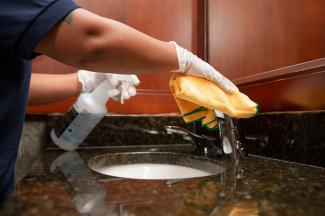How can we avoid a "twindemic"?
In August 2020, The New York Times published an article named “Fearing a ‘Twindemic,’ Health Experts Push Urgently for Flu Shots.” (To read the full article, click here.) The coined phrase “twindemic” refers to the potential of facing two pandemics at once: the ongoing COVID-19 pandemic, and a pandemic-like flu season.
To establish, seasonal flu and pandemic flu are usually two different things. Seasonal flu refers to the flu strains that show up during the flu season (normally in the winter), while pandemic flu is caused by a completely new flu strain, which isn’t confined to a season and easily spreads. However, a bad flu season can create conditions very similar to pandemic flu. The most dangerous of these conditions is overwhelming medical facilities and supplies.

The COVID-19 pandemic has already placed a significant burden on the medical community. If we face a bad flu season this winter, our problems can exponentially increase. The best way to combat a twindemic is to avoid getting sick altogether.
Viruses
Both COVID-19 and the flu are caused by viruses, which means they share many similarities (but are not the same).
Viruses are an unusual microscopic particle, with one of their key characteristics being that they are unable to replicate on their own. It is in essence a parasite that harms and can even kill its host as it tries to reproduce. It starts at a microscopic level, when a virus particle tricks another living cell to let it in. The virus then seizes control of the cell, forcing it to create more virus particles by using the cell’s reproduction abilities. Eventually, the newly created virus particles leave the host cell, often destroying the host cell in the process.
This can be the beginning of a vicious cycle. These new viruses can infect other cells and turn them into more virus factories. With each cell that is taken over, it has the potential to create many more viruses to take over many more cells. If it goes unhindered, a single virus particle can create exponential growth that turns into one million virus particles in only a handful of rounds of virus reproduction.
The reality for virus growth is luckily much more complicated. The immune system is built to combat many unwanted bio contaminants, including viruses. Antibodies bind to viruses and render them unable to enter cells to replicate, while killer T-cells use antigens to identify and destroy seized cells before they can successfully release new virus particles.
The immune system also triggers other body responses to slow the virus down. Fevers, one of the most known symptoms, are hypothesized to be an immune response to slow the temperature-sensitive process of cell and virus production. This, in turn, gives the rest of the immune system more time to deal with the virus.
The drawback of the immune system is that it needs to identify the particle as a virus before it can react. If the body is infected by a completely new virus, it takes time for the body to classify the particle as a virus and produce a response. This is what makes a new virus so dangerous; the time it takes for the body to classify and respond to a virus is time for that virus to multiply and potentially overtake the body.
Also, if you are infected with either the flu or COVID-19, it is still possible to catch other viruses. In fact, catching more than one at a time can put a strain on your body and make recovery even tougher.
Preventing and Mitigating Viral Infection
While the flu and COVID-19 are caused by different types of viruses, the fact that they are both viruses means that precautions taken to stop one will often stop the other. In the southern hemisphere, many places saw a reduction in flu cases while adopting safety measures against COVID-19.
Here are our tips to help reduce you chance of getting either of the viruses this winter:
- Get your flu shot. A flu shot will give your immune system a chance to classify the particles as viruses safely. That way, if you are exposed to influenza strains (the viruses that cause the flu), your immune system can immediately go into action. This reduces the severity of symptoms, and possibly prevents you from having the flu altogether.
- Wash your hands. Viruses can sit on your skin for hours without dying. Water and soap can remove and even kill virus particles. It’s especially important to do this after touching surfaces or objects that others many have touched as well.
- Bring hand sanitizer with you. If you cannot wash your hands, a hand sanitizer with 60% alcohol can be an efficient alternative.
- Wear a face mask. Face masks work as filters for your nose and mouth. The more viruses that the face mask catches, the more viruses that are not entering your body.
- Sneeze and cough into a tissue or an elbow. Even if you’re wearing a mask, this is common courtesy.
- Wipe down surfaces after use. Depending on the surface material, viruses can last from hours to days. If it is touched or handled by multiple people, there’s a risk that it will infect all of them. Use effective cleaners to sanitize and disinfect these spots, especially after they have been used.
- Consider getting an air purifier. Due to the airborne nature of both viruses, getting your air clean has more importance than before. While scientific experiments are still ongoing, experts suggest getting one with a certified HEPA filter if you do get one; HEPA filters create the most effective and efficient air purifiers on the market.
- Set up disinfection stations at your office. Having easily spotted, easily accessible places to get cleaning supplies encourages people to clean more often.
- Talk with your janitorial staff or cleaning service. They have insight to your workplace and areas that need more attention. They may also have other cleaning and disinfecting methods available that you do not know about.
- Find out your workplace’s plan in case there is an outbreak. If you have children, also see what the school’s plans are. Many places have developed contingency plans due to the pandemic. It is important to know what they are and make your own plans, rather than be caught unaware in worse case scenarios.
If you do get sick:
- Stay home, and encourage others to do so. When we get sick, we often think that we’re doing better than we actually are. Staying home not only allows our bodies a chance to fight the virus and recover, but also prevent it from spreading to friends and loved ones.
- Call your doctor. With both COVID-19 and the flu creating similar early symptoms, it’s near impossible to figure out what you have without the help of a doctor. Depending on what you do have, some of their advice on what to do may change.
Get Help from the Experts
When it comes to cleaning for health, Janitronics remains as industry leaders. We have been keeping up with all of the latest science involving the pandemic, and our COVID-19 cleaning process strives to protect our community. We also have experience working through almost fifty years of flu seasons.
To reach out to us, use our contact page.


